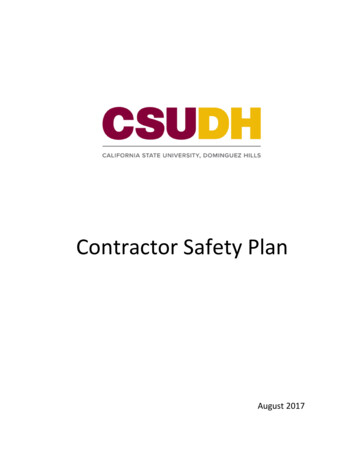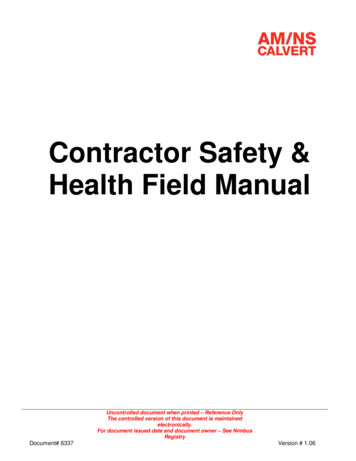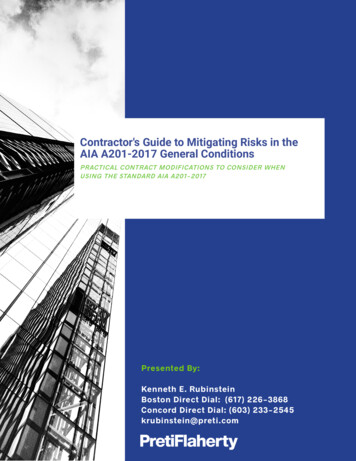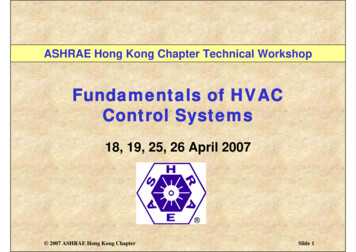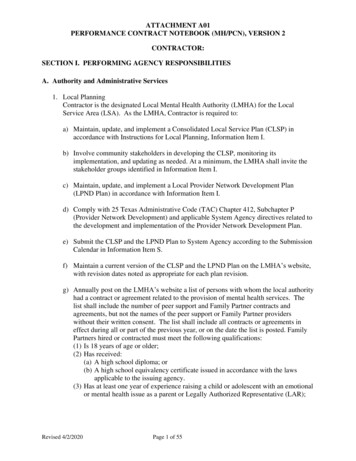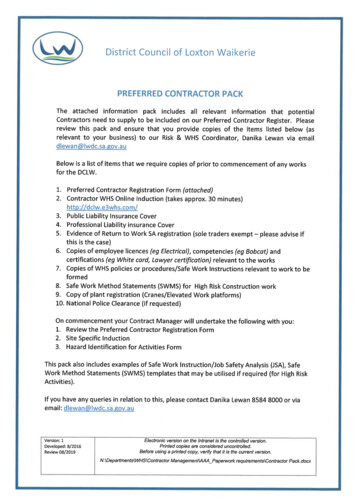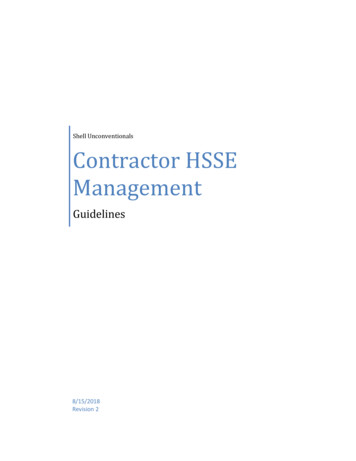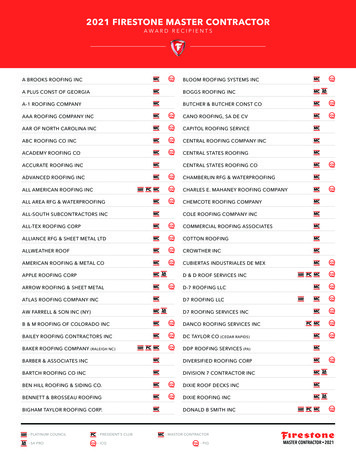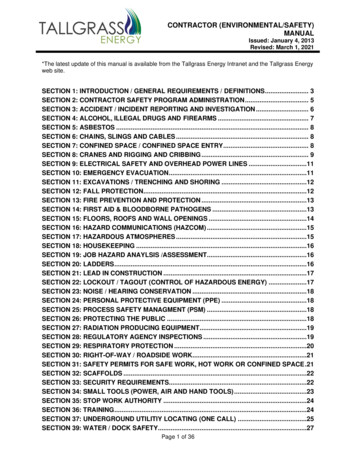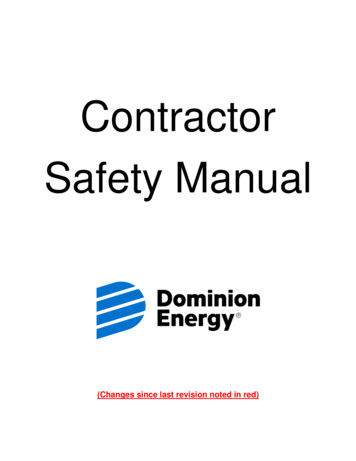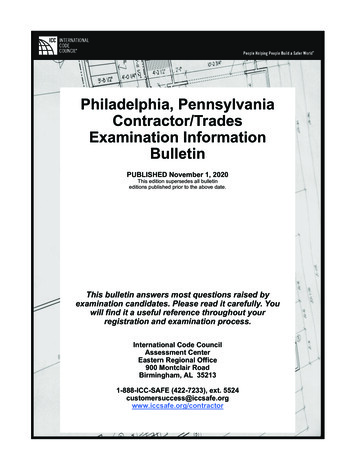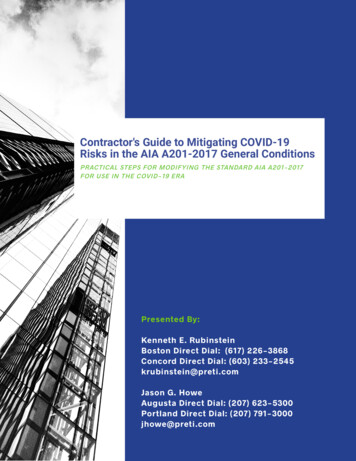
Transcription
Contractor's Guide to Mitigating COVID-19Risks in the AIA A201-2017 General ConditionsPRACTICAL STEPS FOR MODIFYING THE STANDARD AIA A201-2017FOR USE IN THE COVID-19 ERAPresented By:Kenneth E. RubinsteinBoston Direct Dial: (617) 226-3868Concord Direct Dial: (603) 233-2545krubinstein@preti.comJason G. HoweAugusta Direct Dial: (207) 623-5300Portland Direct Dial: (207) 791-3000jhowe@preti.com
Table of ContentsPAGE #Introduction3Proper Owner Financing4Protection for Delays5Relief for Change in Laws/Requirements6PPE and Other COVID-19 Costs7COVID-19 Delays and Force Majeure (Part I)8COVID-19 Delays and Force Majeure (Part II)9COVID-19 Related Cost Escalation10Substantial Completion11Use/Occupancy by Owner12Impacts Between Substantial and Final Completion13Reasonable Safety Precautions/Risk of Infection14Is COVID-19 "Hazardous Material"?15Changes in Laws/Standards and Contractor Warranty16Termination and COVID-19 Related Delays1721 Day Notice18Conclusion19About the Author20
Contractor's Guide to Mitigating COVID-19Risks in the AIA A201-2017 General ConditionsPRACTICAL STEPS FOR MODIFYING THE STANDARD AIA A201-2017 FOR USE IN THE COVID-19 ERAINTRODUCTIONThis guide includes specific recommended changes to the AIA A2012017 to address new risks created by the novel coronavirus. While the AIAA201-2017 is generally a well-understood contract document, COVID-19presents new logistical and economic risks that can leave contractors ata disadvantage unless edits are made.This guide is not intended as a substitute for competent legal advice, anddoes not seek to address every suggested modification that contractorsshould consider. Instead, it focuses exclusively on changes implicatedby the novel coronavirus to serve as a useful resource to help identifypotential risks, and offer potential solutions, that should be carefullyconsidered, related to the pandemic.In each section that follows, we have included the relevant language ofthe A201-2017, with our proposed additions reflected in bold/underlinedtype, and proposed deletions reflected as bold/stricken.3 CONTRACTOR'S GUIDE TO MITIGATING COVID-19 RISKS IN THE AIA A201-2017 GENERAL CONDITIONS MAY 2020
03.ENSURE THAT THEOWNER HAS PROPERFINANCINGThe increased risks and costs associated with COVID-19, as well as theheightened possibility of recession, make projects more precarious andincrease the risk that owners may default on their contractual obligations.Accordingly, it is more important than ever that contractors verify thatowners have sufficient financing to fund the project. The existing A2012017 language allows contractors to delay commencement until theowner provides evidence of financing, but only affords an extension oftime. A delay in starting the project may cause the contractor to incurextended general conditions and other project costs resulting fromthe extended duration. The contractor should be reimbursed for theseadditional costs. Notably, the proposed addition mirrors the languagealready existing within §2.2.2, which allows additional time and costsfor delays resulting from financing-related-suspension.P R O P O S E D L AN G UAG E C HAN G E§ 2.2.1 Prior to commencement of the Work and upon written requestby the Contractor, the Owner shall furnish to the Contractor reasonableevidence that the Owner has made financial arrangements to fulfillthe Owner’s obligations under the Contract. The Contractor shall haveno obligation to commence the Work until the Owner provides suchevidence. If commencement of the Work is delayed under this Section2.2.1, the Contract Time shall be extended appropriately and theContract Sum shall be increased by the amount of the Contractor’sreasonable costs of delay, plus interest as provided in the ContractDocuments.4 CONTRACTOR'S GUIDE TO MITIGATING COVID-19 RISKS IN THE AIA A201-2017 GENERAL CONDITIONS MAY 2020
SECURE PROTECTIONFOR DELAYSRESULTING FROMDELAYED INSPECTIONSSince the advent of COVID-19, different municipal officials have applieddifferent timeframes and standards in conducting inspections. Theproposed language protects contractors from exposure to additionalcosts and delay damages resulting from unexpected or unreasonabledelays or positions by public authorities, whose approval is necessaryto complete the contractor’s obligations.P R O P O S E D L AN G UAG E C HAN G E§ 3.7.1 Unless otherwise provided in the Contract Documents, theContractor shall secure and pay for the building permit as well as forother permits, fees, licenses, and inspections by government agenciesnecessary for proper execution and completion of the Work that arecustomarily secured after execution of the Contract and legally requiredat the time bids are received or negotiations concluded. The ContractSum and Contract Time are based upon a mutual expectation thatreasonable positions will be taken by federal, state, or local inspectorsand officials (“Authorities”), and that such Authorities shall act withreasonable promptness and diligence regarding issuance of permits,approvals, certificates of occupancy, and in interpreting applicablecodes and standards.Contractor shall be entitled to a changeorder adjusting the Contract Sum and Contract Time for any impactresulting from a deviation.5 CONTRACTOR'S GUIDE TO MITIGATING COVID-19 RISKS IN THE AIA A201-2017 GENERAL CONDITIONS MAY 2020
ALLOW RELIEF FORCHANGES IN LAWSAND REQUIREMENTSA recurrence or increase in the number of COVID-19 cases could bringnew rules and legal requirements, which may cause delays and additionalcosts. The proposed additional language protects contractors from therisk of these potential delay damages and additional costs outside ofthe contractor’s control.P R O P O S E D L AN G UAG E C HAN G E§ 3.7.2 Unless otherwise provided in the Contract Documents, theContractor shall secure and pay for the building permit as well as forother permits, fees, licenses, and inspections by government agenciesnecessary for proper execution and completion of the Work thatare customarily secured after execution of the Contract and legallyrequired at the time bids are received or negotiations concluded (“LegalObligations”). In the event that Contractor may be adversely impactedby any change to, or increase of, Legal Obligations (as well as anyadditional health and safety practices required in order to complywith existing Legal Obligations), the Contract Time shall be extendedappropriately and the Contract Sum shall be increased by the amountof the Contractor’s reasonable costs, plus reasonable overhead andprofit thereon.6 CONTRACTOR'S GUIDE TO MITIGATING COVID-19 RISKS IN THE AIA A201-2017 GENERAL CONDITIONS MAY 2020
USE ALLOWANCESFOR PPE AND OTHERCOVID-19 RELATEDCOSTSNo one can predict what construction will look like in the future. Rulesand safety precautions may relax if the pandemic starts to fade or avaccine is discovered, or they may tighten if the number of new casesstarts to rise. Any chaneg in restrictions - whether tighter or looser may have a significant impact on the cost and schedule. Including aCOVID-19 allowance allows the contractor and owner to segregate,track, and address these costs, without sacrificing budget controls forthe project.P R O P O S E D L AN G UAG E C HAN G E§ 3.8.2 Unless otherwise provided in the Contract Documents, .3whenever costs are more than or less than allowances, the ContractSum shall be adjusted accordingly by Change Order. The amount of theChange Order shall reflect (1) the difference between actual costs andthe allowances under Section 3.8.2.1 and (2) changes in Contractor’scosts under Section 3.8.2.2.[CONSIDER INCLUDING AN ALLOWANCE FOR COVID-19RELATEDEXPENSESANDDELAYS. THEEXACTWORDING SHOULD BE CAREFULLY DRAFTED BASEDON THE SPECIFICS OF YOUR PROJECT.]7 CONTRACTOR'S GUIDE TO MITIGATING COVID-19 RISKS IN THE AIA A201-2017 GENERAL CONDITIONS MAY 2020
AMEND THE FORCEMAJEURE DEFINITIONTO INCLUDE COVID-19RELATED DELAYS ANDCOSTS (PART I)The force majeure section of the A201-2017 (§8.3.1) does not includeany specific reference to epidemics or pandemics and does not allowcontractor to recover its costs. Instead, contractors seeking to utilizeforce majeure protections have to rely on the catch-all provision “byother causes that the Contractor asserts, and the Architect determines,justify delay.” While contractors who signed contracts prior to COVID-19could reasonably claim that the pandemic was an unforeseeable event,the same cannot necessarily be said for new projects as COVID-19 isnow a known risk that must be allocated.To avoid any confusion, contractors should a rider to be clear that theowner owns the risk of COVID-19 related delays.P R O P O S E D R I D E R L AN G UAG EIn addition to all rights and remedies set forth in the ContractDocuments, Owner and Contractor are aware of the ongoing pandemicknown as COVID-19, and acknowledge that any delays, additionalcosts, or both may occur as a result. If Contractor is delayed at anytime in the commencement, progress, or completion of the Work, orif Contractor’s work is made more costly, by any cause or conditionarising directly or indirectly from COVID-19, or any other epidemic,pandemic, or public health event, the Contract Time shall be extendedappropriately and the Contract Sum shall be increased by the amountof the Contractor’s reasonable costs, plus reasonable overhead andprofit thereon.8 CONTRACTOR'S GUIDE TO MITIGATING COVID-19 RISKS IN THE AIA A201-2017 GENERAL CONDITIONS MAY 2020
AMEND THE FORCEMAJEURE DEFINITIONTO INCLUDE COVID-19RELATED DELAYS ANDCOSTS (PART II)The AIA language is unclear on whether delay damages are – or are not– recoverable in the event of a force majeure event. The primary forcemajeure clause (§8.3.1) is clear that contractors are entitled to timeextensions but makes no mention of any entitlement to costs. A relatedsection (§8.3.3) states that delay damages are not precluded, however,but it stops short of expressly authorizing such damages.To avoid confusion, this section should be amended to allow contractorsto recover for force majeure related costs. Alternatively, this sectionmay be removed if that issue is addressed in an amendment to §8.3.1,or in an appropriate rider.P R O P O S E D L AN G UAG E C HAN G E§ 8.3.3 This Section 8.3.3 does not preclude expressly permitsrecovery of damages for delay by either party under other provisions ofthe Contract Documents where delay is excused pursuant to §8.3.1.[NOTE: The proposed language makes costs recoverable for all forcemajeure events. This can be restricted to COVID-19 related costs as analternative approach.]9 CONTRACTOR'S GUIDE TO MITIGATING COVID-19 RISKS IN THE AIA A201-2017 GENERAL CONDITIONS MAY 2020
ALLOW RELIEF FORCOVID-19 RELATEDCOST ESCALATIONContractors should consider amending the contract to allow relief forsignificant and unanticipated cost escalation that may result fromCOVID-19.Significant inflation resulting from the cost of the federal response,and impact to supply chains may cause material prices to rapidlyincrease. § 9.1.2 allows contractors to seek relief where the contractuses unit prices, but offers no relief for stipulated sum and guaranteedmaximum price contracts based on current material prices. We typicallyrecommend a threshold that allows for an adjustment when escalationon an item is 10% or higher. This allows owners to avoid feeling nickeland dimed, but provides reasonable protection for the contractor.P R O P O S E D L AN G UAG E C HAN G E§ 9.1.2 If unit prices are stated in the Contract Documents orsubsequently agreed upon, and if quantities originally contemplated arematerially changed so that application of such unit prices to the actualquantities causes substantial inequity to the Owner or Contractor, theapplicable unit prices shall be equitably adjusted. Pricing is based uponreason costs in the industry existing as of the date of the contract.Should labor, equipment, or materials prices escalate on by morethan 10% following execution of the contract, the Contract Sum shallbe increased by the amount of the Contractor’s reasonable costs,plus reasonable overhead and profit thereon.10 CONTRACTOR'S GUIDE TO MITIGATING COVID-19 RISKS IN THE AIA A201-2017 GENERAL CONDITIONS MAY 2020
CLARIFY DEFINITIONOF SUBSTANTIALCOMPLETION TOAVOID POTENTIALCOVID-19 RELATEDCOMPLICATIONSThe A201-2017 definition of "Substantial Completion" is based upon theowner’s ability to use the Work for its intended purpose. This definitioncould be rendered moot if the owner is unable to use the work for itsintended purposes due to regulatory changes affecting the owner, orimposing additional requirements that are not included in the ContractDocuments. To the extent possible, the definition should be clarified toavoid this issue.P R O P O S E D L AN G UAG E C HAN G E§ 9.8.1 Substantial Completion is the stage in the progress of the Workwhen the Work or designated portion thereof is sufficiently completein accordance with the Contract Documents so that (a) the Owner canoccupy or utilize the Work for its intended use, (b) the Work materiallycomplies with the Contract Documents and where the remainingwork does not prevent such occupancy or use, or (c) where the Workmaterially complies with the Contract Documents, but cannot be usedfor such purpose due to causes outside of Contractor’s reasonablecontrol.11 CONTRACTOR'S GUIDE TO MITIGATING COVID-19 RISKS IN THE AIA A201-2017 GENERAL CONDITIONS MAY 2020
LIMIT PARTIAL USEOR OCCUPANCYBY OWNER ANDALLOW RELIEFWHERE SUCH USE OROCCUPANCY IMPACTSCONTRACTORThe standard A201-2017 language allows the owner to occupy aportion of the Work while the balance of the construction is completed.Under the current circumstances, such use or occupancy may presentadditional challenges to contractors who are attempting to employstringent safety protocols and social distancing.Accordingly, thecontract should be amended to allow contractors to refuse permission,or to receive additional time and compensation for any resulting impactif permission is required.P R O P O S E D L AN G UAG E C HAN G E§ 9.9.1 The Owner may occupy or use any completed or partiallycompleted portion of the Work at any stage when such portion isdesignated by separate agreement with the Contractor, provided suchoccupancy or use is consented to by the insurer and authorized by publicauthorities having jurisdiction over the Project. Such partial occupancyor use may commence whether or not the portion is substantiallycomplete, provided the Owner and Contractor have accepted in writingthe responsibilities assigned to each of them for payments, retainage,if any, security, maintenance, heat, utilities, damage to the Work andinsurance, and have agreed in writing concerning the period forcorrection of the Work and commencement of warranties required bythe Contract Documents.When the Contractor considers a portionsubstantially complete, the Contractor shall prepare and submit a list tothe Architect as provided under Section 9.8.2. Consent of the Contractorto partial occupancy or use shall not be unreasonably withheld providedif Contractor is delayed at any time in the progress or completion ofthe Work, or if Contractor’s work is made more costly, by any causeor condition arising directly or indirectly from such partial occupancyor use, the Contract Time shall be extended appropriately and theContract Sum shall be increased by the amount of the Contractor’sreasonable costs, plus reasonable overhead and profit thereon.The stage of the progress of the Work shall be determined by writtenagreement between the Owner and Contractor or, if no agreement isreached, by decision of the Architect.12 CONTRACTOR'S GUIDE TO MITIGATING COVID-19 RISKS IN THE AIA A201-2017 GENERAL CONDITIONS MAY 2020
PERMIT RELIEF FORCOVID-19 IMPACTSOCCURRING BETWEENSUBSTANTIALCOMPLETION ANDFINAL COMPLETIONThe standard A201-2017 language allows contractors to obtain relief ifFinal Completion is delayed through no fault of the contractor. As notedabove, it is unclear whether a COVID-19 related delay would satisfy thisrequirement as an owner could argue that COVID-19 was already aknown risk at the time the parties execute the contract. Accordingly,this language should be amended to make clear that COVID-19 relateddelays will be included among those justifying post-SubstantialCompletion relief.P R O P O S E D L AN G UAG E C HAN G E§ 9.10.3 If, after Substantial Completion of the Work, final completionthereof is materially delayed through no fault of the Contractor(including, but not limited to any cause identified in §8.3 above orotherwise for any cause arising from or relating to COVID-19) or byissuance of Change Orders affecting final completion, and the Architectso confirms, the Owner shall, upon application by the Contractor andcertification by the Architect, and without terminating the Contract,make payment of the balance due for that portion of the Work fullycompleted, corrected, and accepted. If the remaining balance for Worknot fully completed or corrected is less than retainage stipulated in theContract Documents, and if bonds have been furnished, the writtenconsent of the surety to payment of the balance due for that portionof the Work fully completed and accepted shall be submitted by theContractor to the Architect prior to certification of such payment. Suchpayment shall be made under terms and conditions governing finalpayment, except that it shall not constitute a waiver of Claims.13 CONTRACTOR'S GUIDE TO MITIGATING COVID-19 RISKS IN THE AIA A201-2017 GENERAL CONDITIONS MAY
CLARIFY THATTHE CONTRACTORWILL USEREASONABLE SAFETYPRECAUTIONS, BUTCANNOT GUARANTYTHAT NO COVID-19INFECTION WILLOCCURSections 10.1, 10.2, 10.2.3, 10.2.5 make the contractor responsiblefor establishing reasonable protocols to ensure the protection ofemployees working on the project and to avoid and remedy any damageto the property. Contractors should take reasonable precautions, suchas increased PPE, staggering and staging of work, and limitations ofdensity, particularly in enclosed spaces, however, even with the strictestsafety programs, contractors cannot guaranty that COVID-19 will notspread to workers, or be left to reside on surfaces in a manner thatcould be claimed as damage to the Work. Accordingly, additionallanguage should be implemented to limit the contractor’s exposurein these circumstances. To avoid this risk, we recommend addingan additional section, to clarify the contractor’s responsibilities withrespect to COVID-19.P R O P O S E D L AN G UAG E C HAN G E10.2.9Notwithstanding anything to the contrary in this Section10, Contractor’s sole and exclusive responsibility with respect tohealth and safety of persons or property (including but not limitedto Contractor’s employees and the Work) related to COVID-19, shallbe to employ [select either of the following] [reasonable safetymeasures consistent with industry standards ] [or] [the COVID-19safety protocol set forth in Exhibit .]14 CONTRACTOR'S GUIDE TO MITIGATING COVID-19 RISKS IN THE AIA A201-2017 GENERAL CONDITIONS MAY 2020
CLARIFY WHETHERCOVID-19CONSTITUTESA "HAZARDOUSMATERIAL"Section 10.3 provides a lengthy allocation of rights and obligations forhazardous materials existing and brought on the jobsite. The languagedifferentiates these responsibilities based upon whether the hazardouscondition existed before construction commenced or was brought onsite or otherwise released by the contractor. It is not clear from thedefinition whether COVID-19 would constitute a hazardous materialunder the A201-2017's language. The limited lifespan of the virus onsubstances, difficulty in proving the actual cause of infection, andvarious obligations upon the contractor with respect to safety wouldplace contractors at a disadvantage in seeking to argue that the owneris responsible.We recommend amending Section 10.3 to clarify that the term“hazardous material” does not include the novel coronavirus, as it isunclear whether the existence of the coronavirus would constitutea “hazardous material,” but the contractor would likely face an uphillbattle in a dispute on this issue, and the contractor is already regulatedby other sections of the agreement.P R O P O S E D L AN G UAG E C HAN G E§ 10.3.1 The Contractor is responsible for compliance with anyrequirements included in the Contract Documents regarding hazardousmaterials or substances. If the Contractor encounters a hazardousmaterial or substance not addressed in the Contract Documents andif reasonable precautions will be inadequate to prevent foreseeablebodily injury or death to persons resulting from a material or substance,including but not limited to asbestos or polychlorinated biphenyl (PCB),encountered on the site by the Contractor, the Contractor shall, uponrecognizing the condition, immediately stop Work in the affected areaand notify the Owner and Architect of the condition. For purposes ofclarification, COVID-19 shall not be deemed a hazardous material orsubstance for purposes of this Section 10.3.15 CONTRACTOR'S GUIDE TO MITIGATING COVID-19 RISKS IN THE AIA A201-2017 GENERAL CONDITIONS MAY 2020
ADDRESS THE IMPACTTHAT CHANGES INLAW OR STANDARDSOCCURRING AFTERSUBSTANTIALCOMPLETION MAY HAVEON THE CONTRACTOR'SWARRANTYThe one-year warranty included in the A201-2017 requires the contractorto remedy any work found to be not in accordance with the contract’srequirements. To the extent that the contract includes any design-buildelements or other provision requiring the contractor to use discretion,the language should be amended to ensure that the contractor isnot held to a rising standard that may emerge. By way of example,mechanical systems are often specified on a design-build basis andit is easy to envision that the standard of care may increase as morerobust air handling systems are required. In such event, the contractor’swarranty should not require the Contractor to bring the Work up to thehigher standard.P R O P O S E D L AN G UAG E C HAN G E§ 12.2.2.1 In addition to the Contractor’s obligations under Section 3.5,if, within one year after the date of Substantial Completion of the Workor designated portion thereof or after the date for commencement ofwarranties established under Section 9.9.1, or by terms of any applicablespecial warranty required by the Contract Documents, any of the Workis found to be not in accordance with the requirements of the ContractDocuments, the Contractor shall correct it promptly after receipt ofnotice from the Owner to do so, unless the Owner has previously giventhe Contractor a written acceptance of such condition. The Owner shallgive such notice promptly after discovery of the condition. During theone-year period for correction of Work, if the Owner fails to notify theContractor and give the Contractor an opportunity to make the correction,the Owner waives the rights to require correction by the Contractor andto make a claim for breach of warranty. If the Contractor fails to correctnonconforming Work within a reasonable time during that period afterreceipt of notice from the Owner or Architect, the Owner may correctit in accordance with Section 2.5. Notwithstanding the foregoing,nothing herein shall be construed as to require Contractor to performany upgrade or modification to comply with any Legal Requirementor other standard that was not in place as of the date of SubstantialCompletion.NOTE: If the owner insists that the contract require the contractorperform such upgrade or modification, the contract should specify thatthe contractor receive compensation (including reasonable overheadand profit) for such work.16 CONTRACTOR'S GUIDE TO MITIGATING COVID-19 RISKS IN THE AIA A201-2017 GENERAL CONDITIONS MAY 2020
ALLOW FORTERMINATION FOREXTENDED COVID-19DELAYSThe contract allows the contractor to terminate the contract whenwork is stopped for 30 consecutive days due to a government order, orwhere the project is to be delayed by 120 days in a 365-day period dueto delays caused by the owner.Safety precautions such as social distancing, staging and staggering oftrades, and delays in the supply chain may cause significant delays thatchange the very nature of a project. Contractors may wish to considerwhether they want the right to terminate for such extensive delays. Thismay be particularly pertinent for contractors working on projects outof state, or where key personnel may reside elsewhere and may haverelocated for the project.P R O P O S E D L AN G UAG E C HAN G E§ 14.1.2 The Contractor may terminate the Contract if, through no actor fault of the Contractor, a Subcontractor, a Sub-subcontractor, theiragents or employees, or any other persons or entities performingportions of the Work, repeated suspensions, delays, or interruptions ofthe entire Work (a) by the Owner as described in Section 14.3, or (b)attributable in whole or in part to any epidemic, pandemic, or publichealth event, including but not limited to COVID-19, constitute in theaggregate more than 100 percent of the total number of days scheduledfor completion, or 120 days in any 365-day period, whichever is less.17 CONTRACTOR'S GUIDE TO MITIGATING COVID-19 RISKS IN THE AIA A201-2017 GENERAL CONDITIONS MAY 2020
THE 21 DAY NOTICESHOULD BE CLARIFIEDTO ENSURE THAT ALLCOVID-19 RELATEDCLAIMS ARE NOTDEEMED STALEThe contract requires the contractor to provide notice of any claim“within 21 days after occurrence of the event giving rise to such Claimor within 21 days after the claimant first recognizes the condition givingrise to the Claim, whichever is later.” Under this language, an aggressiveowner could argue that the condition at issue, COVID-19, was known toboth parties in February or March of 2020 and is nothing new – eventhough the ramifications to the project may have been unknown untillater. To avoid any dispute, the language should be amended to makeclear that COVID-19 related claims will be deemed to arise when thespecific impact is felt on the project.P R O P O S E D L AN G UAG E C HAN G E§ 15.1.3.1 Claims by either the Owner or Contractor, where the conditiongiving rise to the Claim is first discovered prior to expiration of the periodfor correction of the Work set forth in Section 12.2.2, shall be initiatedby notice to the other party and to the Initial Decision Maker with a copysent to the Architect, if the Architect is not serving as the Initial DecisionMaker. Claims by either party under this section 15.1.3.1 shall be initiatedwithin 21 days after occurrence of the event giving rise to such Claimor within 21 days after the claimant first recognizes the condition givingrise to the Claim, whichever is later. It is acknowledged and understoodthat Claims relating to COVID-19 shall be deemed to have occurredand the time for notice of Claims shall commence running upon thedate that the impact to the Contractor is first observed.18 CONTRACTOR'S GUIDE TO MITIGATING COVID-19 RISKS IN THE AIA A201-2017 GENERAL CONDITIONS MAY 2020
CONCLUSIONThe impact of COVID-19 is not going away. While the number ofcases and fatalities are likely to go down, increased precautions willbe necessary for some time, and these precautions may becomemore severe if the number of new cases increases.Not all changes included in this Guide are appropriate in allcircumstances, and not all risks can be identified in advance. Thatsaid, contractors who consider these changes will be able to makea reasoned and informed decision in entering into new projects inthis new era.19 CONTRACTOR'S GUIDE TO MITIGATING COVID-19 RISKS IN THE AIA A201-2017 GENERAL CONDITIONS MAY 2020
ABOUT THE AUTHORSKE N N E T H E . RU B I N ST E I NKenneth E. Rubinstein is a senior construction attorney and co-chair of thePreti Flaherty Construction Law Practice Group. Ken regularly representsall constituents of the construction industry, including contractors,construction managers, owners, architects, engineers, subcontractors,suppliers, sureties, land surveyors, and others involved in the constructionprocess.DIRECTORBoston, MAConcord, NH(617) 226-3868 (Boston)(603) 233-2545 (Concord)krubinstein@preti.comKen has extensive experience assisting clients in all aspects of construction,including structuring project delivery methods, negotiating contracts andsubcontracts, dispute avoidance and managemen, claims preparation andpresentation, mechanics lien and bond claims, mediation, arbitration, andlitigation. Ken has assisted clients in entering into contracts and resolvingdisputes regarding billions of dollars of construction.Ken is a member of the American Arbitration Association's Panel ofConstruction Arbitrators and was one of the founding co-chairs of theConstruction Law Committee of the Massachusetts Bar Association.Ken is currently the co-chair of the Boston Bar Association ConstructionLaw Committee, and the chair of the Associated General Contractors ofMassachusetts Programming Committee, and a member of the AssociatedBuilders & Contractors of NH/VT Programming Committee. Ken is alsoa member of the adjunct faculty at the Boston University School of Lawwhere he teaches a course entitled “Construction Law and Litigation.”Ken has chaired or presented programs at national and regional events,for organizations such as ENR, the Construction SuperConference, theAmerican Council of Engineering Companies (Annual Conference andFall Convention), Build Boston, Architecture Boston Expo, the ProfessionalLiability Underwriting Society (Annual International Conference), theAssociated General Contractors (National), the Association of GeneralContractors of Massachusetts, the Associated General Contractors of NewHampshire, Associated Builders and Contractor of NH/VT, MassachusettsBar Association, Suffolk University Law School, National Business Institute,Sterling Educational Services, Half Moon Seminars, and Lorman Seminars.Ken has received recognition from Bes
Risks in the AIA A201-2017 General Conditions PRACTICAL STEPS FOR MODIFYING THE STANDARD AIA A201-2017 FOR USE IN THE COVID-19 ERA This guide includes specific recommended changes to the AIA A201-2017 to address new risks created by the novel coronavirus. While the AIA A201-2017 is generall
